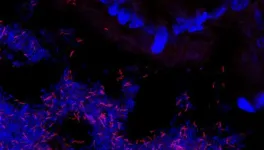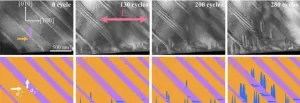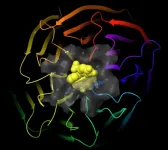(Press-News.org) The unpopular guests are already here. Hazel-, alder- and elm tree pollen sweep in over us during the early spring months, with birch pollen following in May. Then grass follows in June-July before mugwort pollen closes the season in late summer. All leading to more and more people suffering.
Over fifty years, the proportion of young Danes who sneeze, rub itchy eyes or suffer a blocked nose because of pollen has grown from 7-8 per cent in the 1970s to 24 per cent today. And for asthma, the proportion has risen from 4 to 12 per cent during the same period. This is shown by a study of 53,000 Danish blood donors published by researchers from Aarhus University in collaboration with the Blood Bank at Aarhus University Hospital.
The lead author of the study, Susan Mikkelsen, is a PhD student at the Department of Clinical Medicine and a medical specialist in clinical immunology. She points to how the large blood donor study combines questionnaires and blood samples with the possibility of many follow-up studies:
"In the newly published study, 53,000 blood donors from all over the country born in the period from the 1950s and up until the turn of the millennium, completed a questionnaire on a tablet while donating blood," says Susan Mikkelsen, who works as a medical doctor at Department of Clinical Immunology at Aarhus University Hospital while completing her PhD dissertation.
"The blood from 25,000 of the participants has also been examined for antibodies against nine selected allergens, ranging from different types of pollen to animal hair and dust mites. In medical language, we say that the test participants who react by forming antibodies are 'sensitised'," she explains.
The blood samples show that the proportion of sensitised donors increases with the number of allergic disorders. For example, the researchers can see that ninety per cent of those who indicate that they have both asthma and allergic reactions in the nose and eyes, form antibodies.
On the other hand, the proportion of sensitised is only half as large for donors who grew up on a farm with animals, where they are exposed to a range of bacteria, fungi and pollen that might be protective against hypersensitivity.
Susan Mikkelsen also points out that the newly published study, which has been published in Clinical and Translational Allergy, is a so-called conservative research result which cannot be accused of exaggerating the problem - it most likely downplays it. The blood donors are in fact not representative random sample of the Danish population, as they are healthier, in particular the oldest blood donors, due to the requirement that a donor must be 'healthy' to give blood.
"For us, this means that the severe asthmatics aren't included when we calculate the proportion of allergy sufferers, because they simply aren't allowed to give blood. When every fifth blood donor nevertheless ticks the box as allergic and every tenth as asthmatic, this of course tells something about how hay fever and asthma are today very common diseases," says Susan Mikkelsen.
The latter is co-author Torben Sigsgaard's area of expertise. He is professor at the Department of Public Health and acknowledges that we in the Western world are becoming increasingly allergic. This was demonstrated already 15 years ago, for example in the Danish "Glostrup"' studies and the European Respiratory studies.
"Nevertheless, the current study contributes with important knowledge. The study shows, for example, that there is probably some way to go until we in Denmark reach the ceiling for how many people can become allergy sufferers, as the curve doesn't appear to be flattening out as we've seen it do in Switzerland, for example," says Torben Sigsgaard with reference to a theory that there is a maximum limit for how many people in a particular population group will, under the wrong circumstances, develop allergies. The theory is that the Swiss have now reached this maximum, but the specifics remain unclear. Torben Sigsgaard also points out that hay fever and asthma can be severe disorders - even though they are relatively common in Denmark.
"For some young sufferers, hay fever means that they have trouble completing exams, because the pollen season coincides with summer exams. We also know that some people completely opt out of social activities when the allergy is worst, because they think it's too disgusting and inconvenient to have their eyes and nose constantly running," says Torben Sigsgaard, who has many years of experience in the research field.
He emphasises that the large biobank with blood samples allows researchers to continue working with genetic analyses or studies connected to air pollution.
"The uniqueness of the study is that we can examine the participants' blood for biomarkers and genetic markers and compare the findings with environmental impacts, follow-up questionnaire surveys and the Danish registers. This makes it possible to look at the significance of genetic-environmental interaction on allergy and sensitisation. In addition, the repeated blood samples from each participant make it possible to study the immune system before symptom onset in participants with newly developed allergic symptoms," says Susan Mikkelsen.
"We're extremely grateful for the blood donors' contribution to the study. They make their blood samples available for research and thus facilitate our studies," she says.
INFORMATION:
The research results - more information
The study is part of the Danish Blood Donor Study (DBDS), which is a national study of blood donors' health. More than 125,000 blood donors have agreed to participate since 2010.
Partners from Denmark and abroad are The Danish blood banks, Statens Serum Institut, the Centre for Protein Research at the University of Copenhagen, the Danish Headache Centre and Thermo Fisher Scientific. The analytics company Thermo Fischer Scientific provided analyses of the blood samples and received symbolic payment for this but has had no access to the research results beyond what is published in scientific journals.
Diet and the gut microbiome
With the consumption of a single type of vegetable such as spinach, hundreds of chemical components enter our digestive tract. There, they are further metabolized by the gut microbiome, a unique collection of hundreds of microbial species. The gut microbiome thus plays a major role in determining how nutrition affects our health. "So far, however, the metabolic capabilities of many of these microorganisms in the microbiome are still unknown. That means we don't know what substances they feed on and how they process them," explains ...
Researchers at Lund University in Sweden have discovered that bird blood produces more heat in winter, when it is colder, than in autumn. The study is published in The FASEB Journal.
The secret lies in the energy factories of cells, the mitochondria. Mammals have no mitochondria in their red blood cells, but birds do, and according to the research team from Lund and Glasgow this means that the blood can function as a central heating system when it is cold.
"In winter, the mitochondria seem to prioritize producing more heat instead of more energy. The blood becomes a type of radiator that they can turn up when it gets colder", says Andreas Nord, researcher in evolutionary ecology at Lund University who led the study.
Until ...
Ferroelectric materials are used in many devices, including memories, capacitors, actuators and sensors. These devices are commonly used in both consumer and industrial instruments, such as computers, medical ultrasound equipment and underwater sonars.
Over time, ferroelectric materials are subjected to repeated mechanical and electrical loading, leading to a progressive decrease in their functionality, ultimately resulting in failure. This process is referred to as 'ferroelectric fatigue'.
It is a main cause of the failure of a range of electronic devices, with discarded electronics a leading contributor to e-waste. Globally, tens of millions of tonnes of failed electronic devices go to landfill every year.
Using advanced ...
During the acute phase of the COVID-19 pandemic, emergency department doctors, nurses and other frontline staff experienced unprecedented levels of stress and emotional exhaustion that included nightmares or insomnia, according to a UC San Francisco-led study of emergency departments across the country.
The study, among the first to assess mental health effects of the pandemic at a geographically diverse sample of emergency rooms, found that nearly one-fifth of the ER staff were at elevated risk for post-traumatic stress disorder (PTSD).
The study also reported that regular testing for COVID-19 helped to reduce stress among emergency personnel, particularly for those with previous positive antibody ...
COLUMBUS, Ohio - In some men, having traditional masculine characteristics such as competitiveness and adventurousness was linked to being better fathers to infants, a new study found.
But the men in this study - highly educated and from dual-earner couples - combined those stereotypically masculine traits with the belief that they should be nurturing, highly involved fathers.
The researchers were surprised that traits often seen as old-fashioned male stereotypes were linked to more positive parenting behaviors, said study lead author Sarah Schoppe-Sullivan, professor of psychology at The Ohio State University.
It ...
An international research team led by Monash University has uncovered a new technique that could speed up recovery from bone replacements by altering the shape and nucleus of individual stem cells.
The research collaboration involving Monash University, the Melbourne Centre for Nanofabrication, CSIRO, the Max Planck Institute for Medical Research and the Swiss Federal Institute of Technology in Lausanne, developed micropillar arrays using UV nanoimprint lithography that essentially 'trick' the cells to become bone.
Nanoimprint lithography allows for the creation of microscale patterns with low cost, high ...
The concentration of the radioactive element radon is known to change in the ground before and after earthquakes. Previous studies have shown elevated radon levels in the atmosphere before the mainshock of a large inland earthquake due to foreshock activity and slow slip.
But now, researchers from Tohoku University have revealed an anomaly in this phenomenon. Through the analysis of data before and after the 2018 Northern Osaka Earthquake, they discovered that the atmospheric radon concentration decreased.
The results of their research were published online in Scientific Reports on April 2, 2021.
"For the first time, we found a decrease in the atmospheric radon associated with seismic quiescence before the mainshock of ...
A team from the Department of Agronomy at the UCO has demonstrated, through field tests carried out during 8 agricultural seasons, that foliar feeding with fertilizer increases the concentration of zinc in wheat more than if it is applied to the soil
Micronutrient deficiencies pose health problems for a third of the world's population. Worldwide, zinc deficits are more problematic in the rural areas of developing countries, where diets are largely limited to vegetable products grown in soils suffering from low nutrient availability. Biofortification, the process of bolstering the nutritional value of crops by increasing ...
Researchers at the Obesity Research Unit of the University of Helsinki have found that obesity clearly reduces mitochondrial gene expression in fat tissue, or adipose tissue. Mitochondria are important cellular powerplants which process all of our energy intake. If the pathways associated with breaking down nutrients are lazy, the changes can often have health-related consequences.
A total of 49 pairs of identical twins discordant for body weight participated in the study conducted at the University of Helsinki: their body composition and metabolism were studied in detail, and biopsies from adipose and muscle tissue were collected. Multiple techniques for ...
WASHINGTON, April 9, 2021 -- For the millions of people worldwide who have sickle cell disease, there are only a few treatment options, which include risky bone marrow transplants, gene therapy or other treatments that address a subset of symptoms. Today, researchers will describe the discovery of a small molecule with the potential to address the root cause of sickle cell disease by boosting levels of fetal hemoglobin, a healthy form that adults normally do not make. The drug could be formulated into a convenient daily tablet.
The researchers will present their results today at the spring meeting of the American Chemical Society (ACS). ACS Spring 2021 is being held online April 5-30. Live sessions will be hosted April 5-16, and on-demand and networking content will continue through ...




